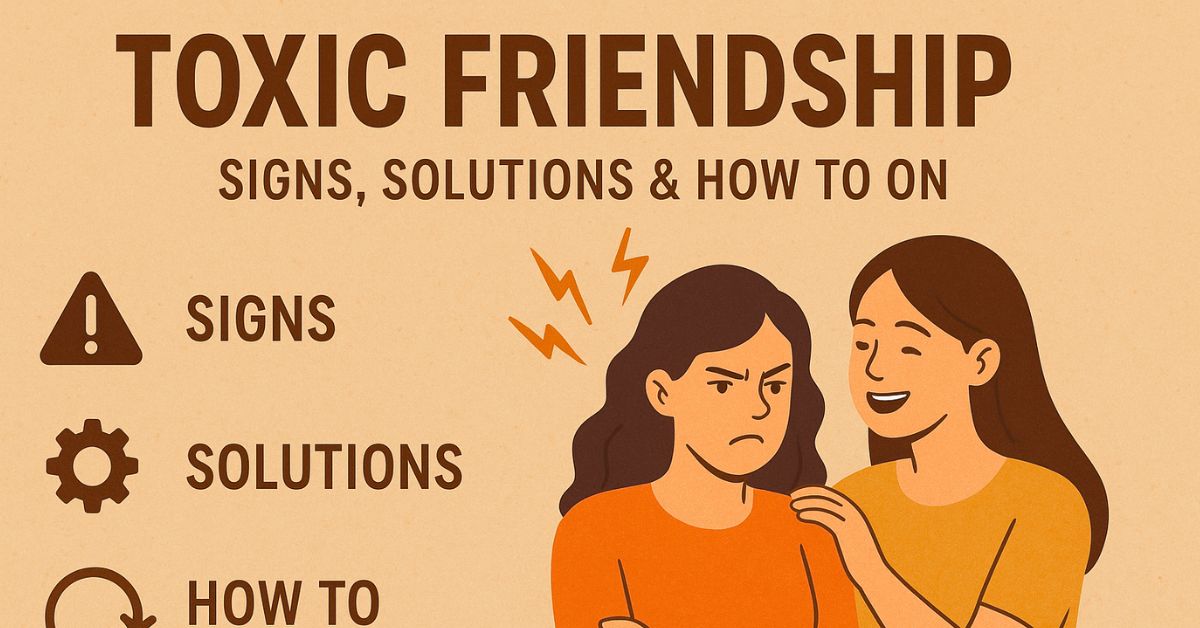A friendship is supposed to be seen as joy, support and shared experiences. But sometimes, a toxic friendship can veer into dragging — or anxiety-provoking. “These relationships can wreak havoc on your confidence, mental health and sometimes even physical well-being.
Studies have found that negative social interactions, such as toxic friendships, are associated with higher levels of stress and anxiety. Keep in mind that identifying the signs of a toxic friendship early can save you from unnecessary trauma and help you retain balance and normalcy with other friends around you.
In the guide below, you’ll see what a toxic friendship is and the signs of a toxic friend, including practical steps to end (or phase out) toxic friendships and expert advice on not only creating strong relationships but healthy ones as well.
Understanding Toxic Friendship
We all get on people’s nerves at times, but a toxic friendship leaves you feeling like a doormat. Unlike a one-off fall-out, toxic friendships are devoid of any good patterns that break or cause harm to your emotional health.
Common Toxic Friendship Types
- The Constant Critic: Always finding fault, rarely praising.
- The Manipulator: Guilt-Inducing, Pressuring, or Leveraging Emotions to Control You.
- The One-Way Friend: Calls for help but rarely offers any in return.
- The Competitive Friend: Makes accomplishments a competition.
- The Passive-Aggressive Friend: Expresses their negative thoughts and feelings through subtle digs or snide, stand-offish comments.
Why toxic friendships are hard to leave:
- Emotional attachment or history
- Fear of confrontation, or bad feelings
- Doubts like: “Am I overreacting?”
Recognizing these signs can empower you to be proactive before the friendship begins to take a heavy toll on your emotional well-being.
What is a Toxic Friendship
A toxic friendship is a relationship where one person consistently drains, criticizes, or manipulates the other. Unlike healthy friendships, it leaves you feeling stressed, undervalued, or anxious over time.
How to Tell if a Friend is Toxic
You can spot a toxic friend if:
- You feel emotionally drained after interactions
- They constantly criticize or belittle you
- The friendship is one-sided
- They manipulate or guilt-trip you
Letting Go of a Toxic Friendship
Letting go of a toxic friendship means prioritizing your well-being. Gradually reduce contact, set boundaries, and seek support from trusted friends or a therapist.
How to Get Over a Toxic Friendship
To overcome a toxic friendship, accept the situation, prioritize self-care, engage in hobbies, and surround yourself with supportive people. Reflection and time help rebuild confidence.
Is My Friend Toxic or Am I Overreacting?
Ask yourself: do you consistently feel drained, anxious, or undervalued? If yes, your friend’s behavior is likely toxic. Occasional conflicts don’t count.
How to Move On from a Toxic Friendship
Moving on involves setting boundaries, reducing contact, focusing on personal growth, and building positive, supportive relationships.
How to Get Out of a Toxic Friendship
Take clear steps: limit interactions, communicate your reasons if needed, and remove yourself from harmful situations. Prioritize your emotional health.
Importance of Identifying Toxic Friendships
Recognizing the signs of a toxic friendship is crucial for maintaining your emotional, mental, and physical well-being. Some key benefits include:
- Mental Health: Stress, anxiety, and emotional burnout are diminished.
- Confidence: Amazing what not getting shit on day in and out will do for one’s personal growth!
- More Efficiency: You are freed to do productive work and enjoy nurturing roles in your relationships.
- Physical Health Benefits: Reduced stress can lower risks of insomnia, headaches, or depression.
- Better Relationship Choices: You’re more equipped to obtain balanced, mutually supportive relationships when you know what toxicity looks like.
If, for instance, meeting with a friend changes guilt, anxiety, or an empty feeling in you all the time, then these are very clear toxic friendship signs that cannot be ignored.
Step-by-Step Guide: How to Deal With a Toxic Friendship
So let’s get down to it, how to deal with a toxic friend the right way.
1. Recognize the Signs
Pay attention to how you feel after interactions. Common toxic friendship signs include:
- Feeling drained, anxious, or upset
- Persistent criticism or belittlement
- One-sided effort in the relationship
- Jealousy or manipulative behavior
2. Assess the Relationship Objectively
Ask yourself:
- Is the friendship one-sided?
- Do I feel taken seriously and valued?
- Do I find myself happy as often as I am stressed?
A journal of interactions lets you see it and identify patterns without seeing red.
3. Set Clear Boundaries
Boundaries protect your emotional health:
- Limit the frequency of contact.
- Avoid topics that trigger conflict.
- Take your needs into consideration and assert them politely but firmly.
4. Communicate Openly
If a conversation is safe, have an honest one:
- Make it about yourself (“I feel hurt when…”)
- Stay calm and factual.
- Avoid blame or confrontation.
5. Seek Outside Perspectives
Friends, family, or a trusted therapist can provide an outsider’s perspective and emotional support.
6. Limit or End Contact Gradually
Sometimes distance is necessary:
- Reduce interactions slowly
- Politely state your reasons if you can
- Prioritize your mental health.
7. Digital Detox from Toxic Friends
Social media can exacerbate toxic dynamics:
- Unfollow or mute temporarily
- Avoid online arguments
- Reduce exposure to emotional triggers.
8. Focus on Self-Care
Healing from a toxic friendship is about self-nurturing:
- “Do something in the realm of inspiration, something you enjoy doing, like walking or yoga.”
- Practice mindfulness, journaling, or meditation
- Consider therapy or joining support groups if necessary.
9. Reflect and Learn
- Learn the signs of trouble in future friendships.
- Strengthen emotional boundaries
- Appreciate supportive, positive relationships.
10. Move On Positively
- Accept the situation without guilt.
- Focus on personal growth.
- Build new, meaningful connections.
The most common pitfalls & myths about toxic friendships
So many people suffer in toxic friendships because they are led to believe something that is not true, or they make decisions from a place of emotional bondage and get caught up in the same whirlwind. Knowing these traps enables you to make more informed choices.
Mistake 1: Ignoring the Problem
Denying reality only permits bad behavior to get out of control. Fatigue, tense feelings, and loss of self-esteem are commonly incurred.
For example, excusing a friend’s relentless pushback with, “They’re always teasing,” can take an emotional toll over time.
Mistake 2: Believing It’s Your Fault
Internalizing blame is common. Thinking, “Am I overreacting?” or “I made them act this way?” is misleading. Having some self-awareness is beneficial, but feeling guilty repeatedly does nothing for your mental well-being.
Note: Keep a ‘toxicity interaction journal’ that will help you identify patterns of encountered toxicity without personalizing them.
Mistake 3: Hoping They Will Change
Remaining in a toxic friendship, hoping for change, often leads to frustration. While change is possible, it requires awareness, effort, and consistent behavioral adjustments.
Example: A friend repeatedly criticizes or manipulates you despite your efforts. Waiting for change can prolong harm.
Mistake 4: Ending the Friendship Abruptly Without Planning
Sudden cutoffs can trigger guilt and emotional turmoil. Instead, let things shrink down slowly – decrease contact, establish boundaries, and get ready for it.
Tip: Take it slow — cut back on meetups, limit emotional conversations, and when the time is right, let him know why you don’t want to be in the relationship calmly.
Mistake 5: Underestimating Emotional Impact
It can seem hard to end a toxic friendship. You may feel guilty, nostalgic, or sad about shared experiences.
Planning activities that promote self-care, such as journaling, therapy, or supportive social connections, can help facilitate this transition.
Mistake 6: Confusing Conflict With Toxicity
Not all disagreements indicate toxicity. Toxic friendships involve repeated patterns of manipulation, criticism, or emotional drain. Normal conflicts are temporary, whereas toxic patterns are persistent.
Tip: Look for repeated emotional harm rather than isolated incidents. Feeling constantly drained or anxious is a strong sign of toxicity.
By avoiding these mistakes, you can take control of toxic friendships, protect your emotional health, and cultivate healthy, supportive relationships.
How to Choose Healthy Friendships
You must be careful in your choice to build meaningful relationships:
- Choose friends who listen actively and encourage growth
- Observe how they treat others; respect reflects character
- Ensure mutual effort; healthy friendships are balanced
- Avoid relationships involving constant comparison, manipulation, or jealousy
- Join local clubs, hobby groups, or online communities with positive cultures
Prioritizing supportive connections helps you avoid toxic friendships in the future.
Expert Insights & Pro Tips
- Psychologists even suggest taking stock of friendships to maintain healthy relationships.
- Emotional intelligence helps identify unhealthy patterns sooner.
- Record a history of harmful acts to make better decisions.
- Good friends or family members can offer clarity when you’re unsure which way to turn.
- Reflection can show you where you stand and what spheres are your own in a friendship, and sometimes adjustments can be made to bring equilibrium.
The American Psychological Association finds that continual negative social exchanges increase cortisol levels, which in turn affect cognitive, emotional, and physical health. It’s important to identify toxic friendships early.
Conclusion
Toxic friendships can sap your energy, lower your self-esteem, and foster self-doubt. The ability to identify toxic friendship signs, establish boundaries with that toxic friend, and take real next steps toward moving on yourself can safeguard your emotional health.
Letting go of a toxic friendship is not failing; it’s an active effort to choose growth, peace, and happiness. Consider your friends, establish healthy boundaries, and focus on the kind of friendships that bring you joy and fulfillment.
FAQs
- What are the main signs of a toxic friendship?
Common signs include constant criticism, manipulation, one-sided effort, emotional exhaustion, and feeling anxious or undervalued after spending time with your friend.
- How do I know if my friend is toxic or if I’m overreacting?
If you consistently feel drained, disrespected, or anxious around them — even after trying to communicate — it’s likely a toxic friendship, not an overreaction.
- How can I end a toxic friendship without drama?
Start by setting clear boundaries, limiting contact gradually, and calmly expressing your feelings if it’s safe. Focus on protecting your emotional health rather than winning arguments.
- What should I do after ending a toxic friendship?
Prioritize self-care, spend time with supportive friends, and engage in positive activities that help you rebuild confidence. Journaling and therapy can also help with emotional recovery.
- Can a toxic friendship become healthy again?
In rare cases, yes — but only if both people acknowledge the problem, take responsibility, and make consistent changes. Otherwise, distance is usually the healthiest option.




